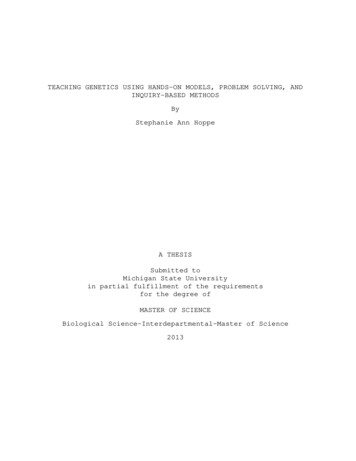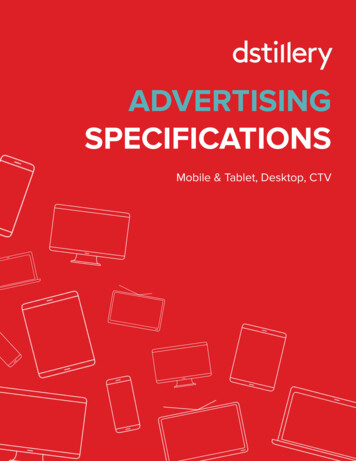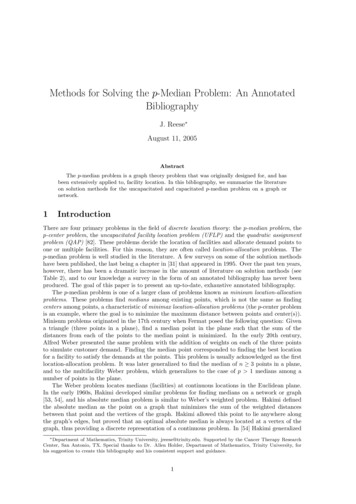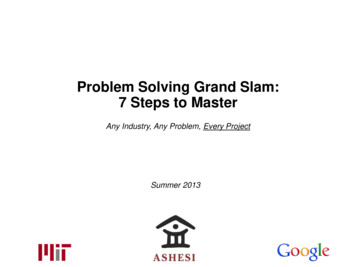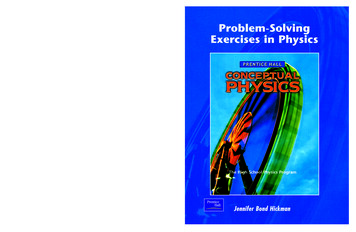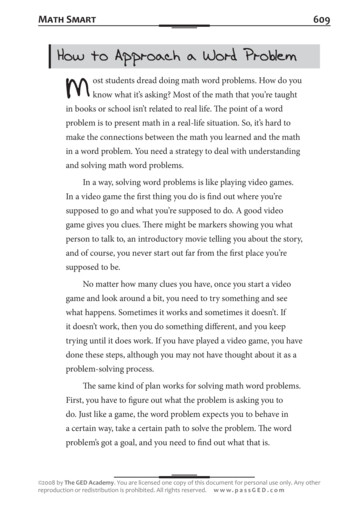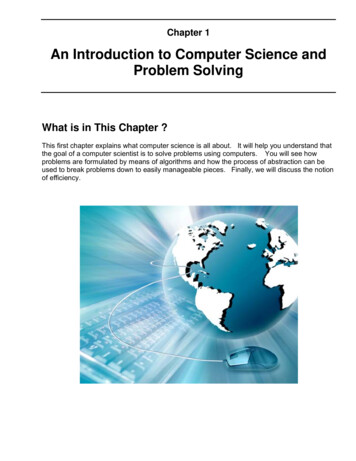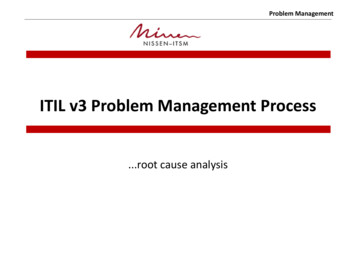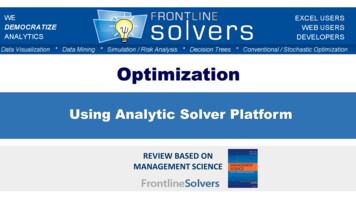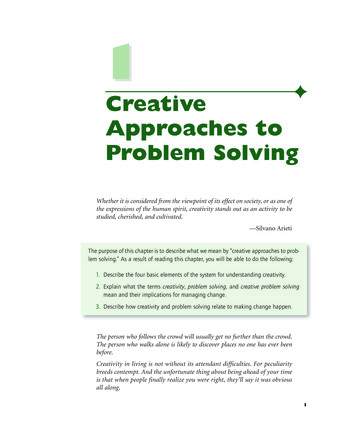
Transcription
1 CreativeApproaches toProblem SolvingWhether it is considered from the viewpoint of its effect on society, or as one ofthe expressions of the human spirit, creativity stands out as an activity to bestudied, cherished, and cultivated.—Silvano ArietiThe purpose of this chapter is to describe what we mean by “creative approaches to problem solving.” As a result of reading this chapter, you will be able to do the following:1. Describe the four basic elements of the system for understanding creativity.2. Explain what the terms creativity, problem solving, and creative problem solvingmean and their implications for managing change.3. Describe how creativity and problem solving relate to making change happen.The person who follows the crowd will usually get no further than the crowd.The person who walks alone is likely to discover places no one has ever beenbefore.Creativity in living is not without its attendant difficulties. For peculiaritybreeds contempt. And the unfortunate thing about being ahead of your timeis that when people finally realize you were right, they’ll say it was obviousall along.1
2 CREATIVE APPROACHES TO PROBLEM SOLVINGYou have two choices in life: You can dissolve into the mainstream, or you canbe distinct. To be distinct, you must be different. To be different, you must bewhat no one else but you can be. . . .—AnonymousThe purpose of this chapter is to prepare you for using the information in this bookto help you make decisions, solve problems, and use your creativity to change yourworld in the direction of your greatest aspirations. Let’s examine the core conceptsbehind Creative Approaches to Problem Solving: A Framework for Innovation and Change.One of our intentions in writing this book is to explore with you a creativitymethod you can use to productively and proactively manage change and produceinnovation. However, one of our assumptions is that you already have experience withmanaging change. Therefore, let’s start with you and your own thoughts about themain concepts in this book.Activity 1.1 Defining Creativity and Problem SolvingTake a minute and write down a few of your first impressions when you see or hear theword Creativity.Now write down a few of the first impressions when you see or hear the words ProblemSolving.The purpose of Activity 1.1 is to help set the stage for understanding what wemean by creative approaches to problem solving. It asks you to identify and list yourperceptions of the key words in our book title. Take a minute to complete the activitybefore continuing to read the chapter.What do you notice about the two lists you created? When we do this exercise inour training courses and workshops, we get plenty of different responses for eachword. However, we also find strong themes in people’s responses, even when weinvolve people from several different cultures. Let’s examine how people haveresponded to the activity and use these responses to examine each topic.What Is Creativity?Creativity is a distinguishing characteristic of human excellence in every areaof behavior.—E. Paul TorranceMost people can readily come up with informal definitions of creativity. Theyoften associate creativity with words such as new, unusual, ideas, out of the ordinary,
Creative Approaches to Problem Solving 3imagination, unique, exciting, wacky, open, fuzzy, or something radically different. It iscommon for them to relate creativity to the arts: composing or performing plays,making great sculpture, the paintings of the masters, writing great literature, composing and performing music, and the like. It’s a word that often has a great deal of positive power and energy associated with it, within and across cultures.On the other hand, it is unusual for people to associate creativity with words suchas usefulness, value, and purposeful. When we probe further, we find that some peopleoften perceive creativity as something not very worthwhile, and in some cases, even assomething quite negative. We have identified three principal myths people hold aboutcreativity. We call them the myths of mystery, magic, and madness.Some people believe that creativity is something so mysterious it cannot be studied productively. They believe creativity comes from an external source over which theindividual has no control. This becomes a problem when it inhibits or interferes withtheir desire or ability to make sense of their own creativity and how they might use it.Other people believe that creativity is something that is magical, which only a fewgifted people really have. This suggests that creativity is a trick that certain peopleknow and if you talk about how the trick is done you will take away the “magic.” If youhold this belief, you separate people into two groups: those who have it and those whodo not. This myth also discourages people from discussing how they use their creativity or how they can nurture it in others.A third common myth is that creativity is linked with madness. In other words, tobe creative, you must be weird, strange, or abnormal. This suggests that creativity isunhealthy behavior, which should be avoided (Figure 1.1).In the face of so many common myths and misconceptions, it is a wonder that creativity has been studied seriously at all. However, there is an alternative set of assumptions and beliefs that allow us to be more productive in learning about and developingcreativity. Creativity is natural (present in everyone), healthy, enjoyable, important,and complex but understandable.Although creativity is a complex and challenging concept, with no universallyaccepted definition, it is understandable. For more than 50 years, people have beenstudying, reading and writing about, theorizing about, and researching creativity.Many theories have been developed to help us understand and organize the complexnature of creativity. Many research studies have established a body of evidence to guideus in understanding, recognizing, and nurturing creativity.Rothenberg and Hausman (1976) support the importance of studying creativity.They stated,The investigation of creativity is at the forefront of contemporary inquiry because it potentially sheds light on crucial areas in the specific fields of behavioral science and philosophyand, more deeply, because it concerns an issue related to our survival: our understandingand improvement of ourselves and the world at a time when conventional means of understanding and betterment seem outmoded and ineffective. (p. 5)Creativity is a natural part of being human. It is not reserved for those peoplewith some sort of special gift. This suggests that creativity exists in all people
4 CREATIVE APPROACHES TO PROBLEM SOLVINGFigure 1.1A Common Perception of CreativitySOURCE: Copyright 2009. The Creative Problem Solving Group, Inc. Reprinted with permission.(at different levels and various styles). The challenge arises from learning how tounderstand and use the creativity you have. This belief is fundamental for thosewho are interested in identifying what creativity is and understanding how it can bedeveloped.Accessing and using creativity can release tension and help people lead healthyand more productive lives. Much of the popular creativity literature tends to focuson those stories of unusual artists or scientists who were highly creative and knownfor rather exotic or strange behavior. We often overlook creative individuals wholead “normal” lives. It can be easy to fall into the trap of believing that people needto display unusual behaviors in order to be creative. In the research conducted oncreativity, there is no evidence to suggest that in order to be creative one must besick, abnormal, or unhealthy. To the contrary, there is some evidence to suggestthat learning how to understand and use creativity can be mentally and physicallyhealthy.
Creative Approaches to Problem Solving 5Creativity is enjoyable in that using it brings about a sense of satisfaction,accomplishment, and reward. When you learn about and apply your creativity, it canprovide you with a sense of peacefulness and joy. Creativity is also important in thatthe outcomes and consequences of using creativity have benefits for individuals,groups, and organizations. Creativity provides important benefits for all people intheir personal life, as well as in their work, and enhances the quality of life for societyas a whole.We are not the first authors to attempt to define creativity. Previous scholarshave collected and synthesized dozens, and even hundreds, of different definitionsoffered by various writers and thinkers (e.g., Treffinger, 1996). For example,Gryskiewicz (1987) defined creativity as novel associations that are useful. This definition came as a result of interviews and analysis of stories of creative performancewith approximately 400 managers in organizations. What we like about this definition is that it is simple and has a built-in tension between something being noveland useful. The novelty part of the definition appears to fit well with most people’sperceptions of creativity. However, the usefulness part of the definition often stimulates questions in people’s minds about whether something needs to be useful inorder to be creative. It also raises questions in general about who determines ifsomething is novel or useful, and therefore, who determines if creativity is presentor not.Ruth Noller, Distinguished Service Professor Emeritus of Creative Studies atBuffalo State College, developed a symbolic equation for creativity. She suggested thatcreativity is a function of an interpersonal attitude toward the beneficial and positiveuse of creativity in combination with three factors: knowledge, imagination, and evaluation (see Figure 1.2). Children are often viewed as naturally strong in imagination.They often need help in acquiring knowledge and expertise, as well as in understanding appropriate criteria for evaluating ideas or behavior. In comparison, practicingprofessionals often are seen as having a great deal of knowledge and evaluative strengthbut as needing help with imagination.Figure 1.2Noller’s Symbolic Formula for Understanding CreativityC fa(K,I,E)Creativity is a function of Knowledge, Imagination, andEvaluation, reflecting an interpersonal attitude toward thebeneficial and positive use of creativity.
6 CREATIVE APPROACHES TO PROBLEM SOLVINGYou might learn a number of lessons from Noller’s equation. One is that creativity is a dynamic concept. It changes through our experience. Also, creativity alwaysoccurs in some context or domain of knowledge. But, while expertise is important andnecessary, it is not sufficient for determining creativity. Finally, creativity involves adynamic balance between imagination and evaluation.Despite the many different definitions of creativity, you can make some sense outof them. Just look back to what you wrote down during the first activity in this chapter.As Welsch (1980) indicated,The definitions of creativity are numerous, with variations not only in concept, but in themeaning of sub-concepts and of terminology referring to similar ideas. There appears tobe, however, a significant level of agreement of key attributes among those persons mostclosely associated with work in this field. . . . On the basis of the survey of the literature, thefollowing definition is proposed: Creativity is the process of generating unique products bytransformation of existing products. These products must be unique only to the creator,and must meet the criteria of purpose and value established by the creator. (p. 107)Rather than trying to subscribe to one single definition of creativity, we use abroad framework originally offered by Rhodes (1961) to organize the diverse and largenumbers of definitions. Rhodes collected 56 definitions of creativity and reported,As I inspected my collection I observed that the definitions are not mutually exclusive. Theyoverlap and intertwine. When analyzed, as through a prism, the content of the definitionsform four strands. Each strand has unique identity academically, but only in unity do thefour strands operate functionally.Rhodes (like many other scholars) found it more productive to describe creativitywithin four overlapping themes. These themes include definitions of the characteristics ofcreative people, the operations within the creative process, the creative results and outcomes, and the context or place for creativity. Isaksen (1984) put these four themes into aVenn diagram (see Figure 1.3) to represent the interaction that occurs among the four elements and the need to consider the whole system to obtain the best picture of creativity.There are some in the creativity field who feel that this framework is old and tired andthat it should be retired or broadened. Unfortunately, most do not offer an alternative. Weknow of two alternatives that have been offered as general models for outlining inquiry forthe broad field of creativity research. One is specifically focused on formulating research(Isaksen, Stein, Hills, & Gryskiewicz, 1984). The other is designed to provide a frameworkand name for the entire emerging discipline of creativity (Magyari-Beck, 1993).Those who complain about the “4P’s” (person, process, product, and press) modelseen in Figure 1.3 present an argument that is similar to complaining about the periodictable of elements. These four broad themes are simply the way creativity has been definedand how it is found in the literature. We see value in this general way to classify our understanding of creativity because it provides a comprehensive model that embraces a numberof different and important perspectives on this subject. It also provides a view of the entiresystem of creativity. We refer to it as a system because each of the four elements is a
Creative Approaches to Problem Solving 7Figure 1.3Systematic Approaches to CreativityPersonProcessCharacteristicsof peopleOperationsthey performPressProductClimate, culture,contextResultantoutcomesSOURCE: Copyright 2009. The Creative Problem Solving Group, Inc. Reprinted with permission.necessary and interrelated part of the whole concept of creativity. Each element influencesthe other elements. It is difficult to get a complete or true picture of creativity when onepart of the system is left out.The following four subsections will provide you with a short summary of each ofthe four P’s.Characteristics of Creative PeopleCreative personality is . . . a matter of those patterns of traits that are characteristic of creative persons. A creative pattern is manifest in creative behaviorwhich includes such activities as inventing, designing, contriving, composing,and planning.—J. P. GuilfordMuch of the initial interest in creativity among psychologists and others workingin applied settings started with curiosity about how highly creative people were able todemonstrate their creativity. Some of the initial approaches to understanding the
8 CREATIVE APPROACHES TO PROBLEM SOLVINGcharacteristics of creativity in people involved finding and describing individuals whowere generally agreed on as being highly creative. The major challenge facing investigators who followed this approach was in determining how much creativity the individuals had. As a result of this approach, we had a great deal of information regardingthe cognitive and affective characteristics of highly creative people.Early writers in this area often focused on describing creative geniuses, thosepeople who have special and significant talents and gifts. More recently, scholarshave taken a more inclusive approach and looked for extraordinary creativity inordinary people. Most researchers and educators have emphasized the level aspect tocreativity in people. The major question for them is “How creative are you?” It waseasy with the historical geniuses, but much more difficult if we look at everyday creativity. For example, MacKinnon (1978) indicated that there were many differentpaths along which people travel toward the full development and expression of theircreative potential. Rather than trying to put creative people into a single mold, hesaid, “the full and complete picturing of the creative person will require manyimages” (p. 186).A great deal of this research led to the identification of a large number of characteristics associated with highly creative people (Puccio & Murdock, 1999; Treffinger,Young, Selby, & Shepardson, 2002). However, as you read the sample list in Figure 1.4,you will probably begin asking yourself some important questions such as: To be creative, is it necessary to demonstrate all the characteristics in the list? If not, howmany? Does anyone really demonstrate all those characteristics? All the time? Isn’t that a littleunlikely? Are these “traits” (aspects of your personality that are “with you” all the time) or patterns of behavior that might describe how someone acts once in a while? Wouldn’t many of the characteristics vary, depending on what task the person might beworking on and how she or he feels about and reacts to that task? Might they not alsochange over time, or in different situations?These are not easy questions to answer. The traditional view of traits in highlycreative people fosters the belief that those characteristics are only held by those atthe very top of the spectrum—geniuses and those who are famous for their productions. Clearly, these characteristics may be held by everyone, at all levels, tosome degree.Some people might also believe that these characteristics are fixed and cannot bemodified or enhanced. Our experience and research indicate quite clearly that creativity characteristics are dynamic and changeable (see Isaksen, 1987; Isaksen, Murdock,Firestien, & Treffinger, 1993). Although many writers emphasize identifying high orlow creativity, the challenge might be more appropriately posed as nurturing anddeveloping creative characteristics within everyone.A more recent approach to the study of creativity in people concerns how peopleshow the creativity they have. Rather than asking the question, “How creative am I?” it
Creative Approaches to Problem Solving 9Figure 1.4Some Characteristics of Being CreativeFlexibilityOriginalityElaborationHigh essRisk-takingComplexityImaginationTolerance of ambiguityCapacity to make order from chaosasks the question, “How am I creative?” This question deals more specifically with theform, kind, or style of creativity, rather than the level, degree, or amount.We believe that it is important to recognize, understand, and access the full spectrum of creative talent in people. This includes the natural diversity in orientation thatpeople have toward creativity, as well as the full range of knowledge, abilities, and skillspeople bring to the table when solving problems creatively. Understanding your personal creativity, and the creativity of those around you, will help you be more successful in deliberately using your creativity.You will read more about this area of creativity and its relationship to CreativeProblem Solving (CPS) in Chapter 7.Operations Within the Creative ProcessThe art of thought, like the art of running, or the actor’s art of significantgesture, is an attempt to improve by conscious effort an already existing formof human behavior.—Graham WallasThe creative process is also one of our four essential aspects of creativity. It is concerned with how creativity takes place. It examines the mental or cognitive processing,or the thinking that occurs, as people use their creativity. Much of our early research
10 CREATIVE APPROACHES TO PROBLEM SOLVINGon the creative process involved reports of how highly creative people described theprocesses they went through to develop their products. This type of investigation isbased on the assumption that we cantake a single achievement or thought—the making of a new generalization or invention, orthe potential expressions of a new idea—and ask how it was brought about. We can thenroughly dissect out a continuous process, with a beginning and a middle and an end of itsown. (Wallas, 1926, p. 79)One of the challenges to studying the creative process was developing an accuratedescription of a person’s internal thought processes. The goal was to help make thecreative process more visible and understandable in order to improve creative thinking. Many different artists, scientists, composers, poets, and inventors made attemptsto describe their creative moments. A variety of scholars during the 20th centurybecame interested in productive or reflective thinking and the art of thought (Dewey,1933; Ghiselin, 1952; Koestler, 1969; Spearman, 1931; Wallas, 1926; Wertheimer, 1945),resulting in many different attempts to describe the best thinking that humans couldaccomplish.Wallas (1926) developed one of the early descriptions of the creative process (seeFigure 1.5) based on numerous descriptions of famous artists and scientists. He suggested that the art of thought included four stages: (1) preparation (investigating theproblem in all directions), (2) incubation(thinking about the problem in a “not conFigure 1.5 Wallas’ Creative Processscious” manner), (3) illumination (the appearance of the “happy idea”), and (4) verification(validity testing and reducing the idea to anexact form). This demonstrated that you coulddeliberately identify the creative process.In the 1930s, Alex Osborn (1942, 1953)pursued his interest in the human imaginaPREPARATIONtion and began reading the research on andINCUBATIONexperimenting with practical procedures forILLUMINATIONencouraging creative thinking by the peopleVERIFICATIONwith whom he worked. His initial description of CPS built on the work of Wallas,Spearman, and others, and helped change theperception that the creative process couldonly happen intuitively or implicitly. He alsoworked to develop deliberate strategies for itsuse in groups.Another outcome from pursuing an improved understanding has been a diversity of strategies and methods that can be helpful to anyone who is attempting to bedeliberately creative. These strategies can include deliberately shifting your perception about a problem by using analogies or metaphors, setting aside the problem to
Creative Approaches to Problem Solving 11allow for incubation and insight, or seeking inspiration from great works of music orart. There are as many strategies as there are stories from highly creative people abouttheir creativity.Removing Blocks and Barriers. Many of the strategies for increasing your personal creativity come from an understanding and removal of your personal barriers or blocksto creative thinking. You may notice that in some situations you feel confident aboutyourself and your ability to succeed in a particular task, while in other situations youdo not. As depicted in Figure 1.6, one aspect of your approach to creativity is yourawareness of blocks to creative thinking and behavior.It is only natural to have some resistance to novelty. Novelty requires you tochange the approach, behavior, or way of thinking. It requires new learning and mayincrease the possibility of failure. Your internal climate is most likely formed as a resultof some interaction between who you are and the environment or situation in whichyou operate. One of the ways to reduce the effects of blocks and barriers is to increasethe likelihood of developing your strengths. Another way to overcome barriers is toFigure 1.6Blocks to Creative ThinkingSOURCE: Copyright 2009. The Creative Problem Solving Group, Inc. Reprinted with permission.
12 CREATIVE APPROACHES TO PROBLEM SOLVINGknow what they are and whether or not they are keeping you from productivelymaking use of your strengths. You will overcome obstacles more effectively when youare conscious of their presence and impact.There are three broad, overlapping categories of blocks: personal, problem solving, and environmental (situational). Examples of personal blocks include lack of selfconfidence or self-image; a tendency to conform; a need for the familiar, habit-boundthinking; emotional numbness; saturation; excessive enthusiasm; various values andcultural influences; and lack of imaginative control.As an example of personal blocks, Jones (1987) discovered four major categoriesof barriers in the literature. These included strategic, value, perceptual, and self-imagebarriers. Strategic barriers relate to the inability to see and use a variety of possibilitiesfor problem solving. Examples of strategic barriers include resistance to using imagination, an inability to tolerate uncertainty, and the inability to keep an open viewpointto new ideas.Value barriers reflect the lack of flexibility displayed in applying personal values,beliefs, and attitudes. Examples of this kind of barrier include being rigidly custombound, having a strong desire to conform to preexisting patterns, and having dogmatically negative attitudes toward creative thinking.Perceptual barriers relate to seeing things in rigidly familiar ways and usuallyinvolve aspects of sensual acuity and awareness of the environment. Having difficultyin seeing a problem from a variety of viewpoints, imposing unnecessary constraints,failing to use all the senses, and stereotyping are examples of this kind of barrier.Self-image barriers describe conditions where people do not assert themselves ormake use of available resources. Sometimes, people have an extreme fear of failure, havea reluctance to exert influence, or simply fail to take advantage of resources aroundthem. These barriers are easily related to other problem-solving and situational blocks.Problem-solving blocks are strategies, skills, or behaviors that inhibit your abilityto focus and direct problem-solving activities, generate and identify options and alternatives, or turn ideas into action. Some problem-solving blocks include solution fixedness, premature judgments, habit transfer, using poor problem-solving approaches,lack of disciplined effort, poor language skills, various perceptual patterns that limitintake, and rigidity.Environmental blocks are those factors in your context, situation, or setting thatinterfere with your problem-solving efforts. Environmental (situational) blocks to creativity include the belief that only one type of thinking is required for creative outcomes, resistance to new ideas, isolation, a negative attitude toward creative thinking,autocratic decision making, reliance on experts, various strategic blocks that limit theuse of resources, and an overemphasis on competition or cooperation. We will lookmore deeply into these barriers and the conditions necessary for their removal in thesection on the context for creativity.We believe that most creativity methods today share common core foundations andrelate to the creative process outlined by Wallas and Osborn. Although these methods
Creative Approaches to Problem Solving 13may appear distinct on the surface, they are likely to be guided by solid foundationalprinciples associated with how highly creative people naturally use their creativity.Work on understanding the creative process continues today. Beyond the work ofthose who follow the tradition established by Osborn, there are practical books suchas Creating Minds (Gardner, 1993) and The Mind’s Best Work (Perkins, 1981). In addition, there have been advances in cognition and neuroscience that can provide evenfurther insight into the nature of the creative process (Boden, 1991; Carroll, 1993;Dietrich, 2007; Kaufmann, Helstrup, & Teigen, 1995; Ward, 2004, 2007).This book is mainly about a particular approach to understanding the creativeprocess, called Creative Problem Solving. An overview of this approach is more fullydescribed in Chapter 2.Creative Results and OutcomesCreativity may be defined, quite simply, as the ability to bring something newinto existence.—Frank BarronCreative products or outcomes come in a variety of sizes and shapes and frommany different contexts. Many people think of an outstanding play or novel, an inspiring painting or song, or a significant invention or discovery when they think aboutcreative products. They are not limited to either the arts or the sciences. Creative products can be found in the arts, the sciences, the humanities, or any other discipline ordomain of human endeavor. They can be the result of the efforts of individuals orgroups. They may have varying degrees of novelty and usefulness.Creative products can be both tangible and intangible. They may be concrete or“touchable,” such as an invention or marketable product. Other creative outcomes canbe intangible, such as learning and personal development, the development of a newservice or improvement of an existingone, social technology, or the design of aFigure 1.7 Creativity Versus Innovationnew process or methodology.For many people, this area of studyhasbeencalled “innovation” rather thanCREATIVITYINNOVATION“creativity” because of the focus on product rather than process (see Figure 1.7ImaginationImplementationfor other distinctions). Since innovationProcessProductis often considered to be the commercialGeneratingDevelopingization of a new idea, we see it as a partof the creativity system outlined above.NoveltyUsefulnessThe reasons some prefer to use the termSoftHardinnovation over creativity include theneed to focus on obtaining concrete
14 CREATIVE APPROACHES TO PROBLEM SOLVINGresults, preferring to stay focused on what is useful and easier to understand, and theneed to avoid such fuzzy concepts as people and process. Our position is simple. Youcan have creativity without innovation, but you cannot have innovation withoutcreativity (see Isaksen & Tidd, 2006).MacKinnon (1975) pointed out the importance of studying creative products.He stated:In a very real sense . . . the study of creative products is the bas
behind Creative Approaches to Problem Solving: A Framework for Innovation and Change. One of our intentions in writing this book is to explore with you a creativity method you can use to productively and proactively manage change and produce innovation. However, one of our assumptions
